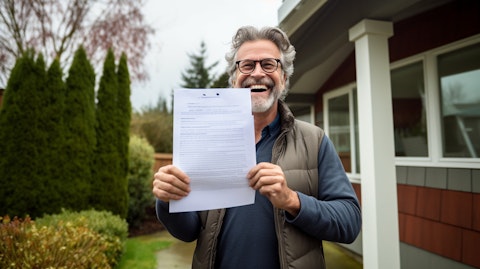HCI Group, Inc. (NYSE:HCI) Q2 2025 Earnings Call Transcript August 9, 2025
Operator: Good afternoon, and welcome to HCI Group’s Second Quarter 2025 Earnings Call. My name is Paul, and I will be your conference operator. [Operator Instructions] Before we begin today’s call, I would like to remind everyone that this conference call is being recorded and will be available for replay through September 6, 2025, starting later today. The call is also being broadcast live via webcast and available via webcast replay until August 8, 2026, on the Investor Information section of HCI Group’s website at www.hcigroup.com. I would now like to turn the call over to Bill Broomall, VP of Investor Relations. Bill, please proceed.
Bill Broomall: Thank you, and good afternoon. Welcome to HCI Group’s Second Quarter 2025 Earnings Call. To access today’s webcast, please visit the Investor Information section of our corporate website at www.hcigroup.com. Before we begin, I would like to take the opportunity to remind our listeners that today’s presentation and responses to questions may contain forward-looking statements made pursuant to the Private Securities Litigation Reform Act of 1995. Words such as anticipate, estimate, expect, intend, plan and project and other similar words and expressions are intended to signify forward-looking statements. Forward-looking statements are not guarantees of future results and conditions, but rather are subject to various risks and uncertainties.
Some of these risks and uncertainties are identified in the company’s filings with the Securities and Exchange Commission. Should any risks or uncertainties develop into actual events, these developments could have material adverse effects on the company’s business, financial conditions and the results of operations. HCI Group disclaims all the obligations to update any forward-looking statements. Now with that, I’d like to turn the call over to Karin Coleman, Chief Operating Officer. Karin?
Karin Sue Coleman: Thank you, Bill, and welcome, everyone. HCI reported another great quarter. Highlights for the second quarter include reported earnings of $5.18 per share. We improved the net combined ratio to 62% and total shareholders’ equity grew to $759 million, up 65% year-to-date. In addition to these financial achievements, we had several other important developments in the quarter. We reduced our debt-to-cap ratio to less than 10%. Homeowners Choice, TypTap Insurance Company and Tailrow Reciprocal Exchange were each approved for depopulation from Citizens in October of this year. Also, HCI successfully placed its reinsurance program for the 2025, 2026 treaty year. Our conservative reinsurance strategy ensures we are well protected for the year ahead.
The technology developed at Exzeo continues to play an important role in HCI’s success and is a real differentiator. For example, it has enabled HCI to identify favorable market shifts early. We detected improvements in Florida’s underwriting environment ahead of many peers, and we executed on that opportunity. We’ve been able to scale rapidly without compromising underwriting discipline. HCI has grown in-force premium by more than $460 million to approximately $1.2 billion since the end of 2022. The technology has allowed HCI to select and retain the right customers, supporting a retention ratio of about 90% and our gross loss ratio improved during that time to below 25% Collectively, Exzeo’s technology has delivered meaningful value to shareholders as reflected in HCI’s strong financial performance in recent quarters.
Looking ahead, irrespective of market conditions, we’re confident that our experienced team, combined with our technology will continue to help identify and underwrite attractive policies that align with our risk and profitability standards. With this advantage, we believe HCI is well positioned to generate compelling returns on shareholder capital. Now I’ll turn it over to Mark to provide more details on our financial results.
James Mark Harmsworth: Thanks, Karin. Pretax income for the quarter was just over $94 million and diluted earnings per share were $5.18 compared to $4.24 in the second quarter last year. Year-to-date, pretax income is $195 million and diluted earnings per share are $10.57. This significant continuing improvement is driven by higher premiums, a lower loss ratio and lower operating expenses as a percentage of premiums. The gross loss ratio this quarter was 21.3%, up slightly from the first quarter this year, but more than 6 points lower than the second quarter last year, reflecting the continuing decline in claims frequency. We also continue to generate significant operational leverage as evidenced by the lower operating expenses as a percentage of revenue.

When combined with lower loss ratios, the result is a combined ratio, which was just under 62% for the second quarter. As we announced back in June, we completed our reinsurance program for the year. Because of the effective — because the effective date of the new program is June 1, part of the impact shows up in the second quarter, but the full impact will be reflected in the third quarter. At that time, premium ceded to reinsurance will be $106 million per quarter, just slightly higher than they were in the first and second quarters. Once the full effect of the new program is reflected, we expect the net combined ratio to be about 70%. Now let’s look at the balance sheet, which continues to strengthen. In June, we redeemed the remaining balance of our 4.75% convertible notes, fully settling the $172 million obligation.
As Karin mentioned, this brings the debt-to-cap ratio well under 10% and interest expense going forward will now be a little less than $1 million per quarter, which is less than 1/3 of what it had been. Due in part to this redemption, but also because of continued profitability, shareholder equity has grown by more than $300 million so far this year and is now well over $0.75 billion. Book value per share has grown by more than $16 so far this year to $58.55 at the end of June. In terms of holding company liquidity, it’s just over $250 million at the end of the second quarter, and there is now very little debt at the holding company level. To summarize, this was another fantastic quarter for the company. The company is growing, but even more importantly, all of our financial metrics continue to improve.
The loss ratio continues to come down. The combined ratio continues to come down and the balance sheet continues to get stronger. And with that, I’ll hand it over to our President of Exzeo, Kevin Mitchell, to give us an update on Exzeo.
Kevin Mitchell: Thanks, Mark. We remain excited about our momentum at Exzeo. As we have mentioned on our prior earnings call, we are moving forward with our plans to have Exzeo be a separate publicly traded entity. After careful consideration of all of our options, we believe the best path is to pursue an initial public offering of Exzeo shares. Earlier this week, Exzeo confidentially submitted a draft registration statement on Form S-1 with the U.S. Securities and Exchange Commission relating to a proposed initial public offering of Exzeo’s common stock. As a result, our CFO, Suela Bulku, and I won’t be making statements on Exzeo’s results in the near term. Additionally, with the suggestion of counsel, we are advised to provide the following disclosure.
The size and price range of the proposed offering by Exzeo have not yet been determined. The initial public offering is expected to take place after the completion of the SEC review process, subject to market and other conditions. There is no assurance that the initial public offering will be completed. We note that this announcement regarding Exzeo is being made under SEC Rule 135 and does not constitute an offer to sell or the solicitation of an offer to buy securities. Furthermore, it does not constitute an offer, solicitation or sale in any jurisdiction in which such offer, solicitation or sale would be unlawful prior to registration or qualification under the securities laws of that jurisdiction. Now I want to turn the call over to Paresh.
Pareshbhai Suryakant Patel: Thank you, Kevin. As Karin and Mark highlighted in their comments, HCI reported another quarter of strong financial results. Kevin’s exciting comments on Exzeo reminded me of a time 18 years ago. Last week marked the 17th anniversary of HCI’s IPO. The company has come a long way since going public in 2008 in the middle of the great financial crisis. But over the past 18 years, our management team has always been guided by a central principle, building long-term shareholder value. And along the way, there’s always been ups and downs, but what matters most is what you achieve, not where you begin. As an example, 18 years ago, you wouldn’t have predicted that we would grow earnings 25x or increase the share price by 20x and increase the shareholders’ equity over 30x.
I note that because our management team has a proven track record of delivering strong long-term returns for our shareholders, and we are all very committed to building on that success. Please join us as we embark on the next leg of our journey. Our best days are in front of us. And with that, I will turn it over for questions.
Operator: [Operator Instructions] The first question today is coming from Matt Carletti from Citizens Capital Markets.
Q&A Session
Follow Hci Group Inc. (NYSE:HCI)
Follow Hci Group Inc. (NYSE:HCI)
Receive real-time insider trading and news alerts
Matthew John Carletti: Paresh, maybe I’ll start. I was hoping that you might be able to kind of update us on what you’re seeing market condition-wise in Florida, competitive landscape and so forth.
Pareshbhai Suryakant Patel: I’m going to give that question to Karin.
Karin Sue Coleman: Sure. Thanks, Paresh. The environment in Florida now is a healthy one, as you can see from our financial results. It’s natural that it will attract capital and competition, but that’s not new to us. We’ve been around for a long time and have succeeded in all kinds of markets. The more competitive market is already here. Look at the 2023 takeout process. That was somewhat competitive in 2024, even more so. But even with that, we got more policies than we thought we would get. The attrition of those policies has been less than what we thought and the loss ratio has been lower than we thought. So we believe we’re well positioned in a competitive market. We have multiple underwriters that can pursue different strategies. We have a strong capital position. And as I mentioned earlier, we have the people and the technology to make the right decisions.
Matthew John Carletti: Maybe Karin, sticking with that, you mentioned in your prepared remarks about HCI and Tailrow being approved for an October depop. Can you just give us kind of your outlook for maybe what we should expect as we progress through kind of the balance of the year in terms of any of the HCI entities, what appetite for depop might be or prospects for it?
Karin Sue Coleman: Sure. The 3 carriers I mentioned earlier, Homeowners Choice, TypTap and Tailrow, each have been approved for 25,000 policies in October. And we’ll leverage our technology as we’ve done in the past to identify those greenhouses that you know that we focus on. So there’ll be some that we want, and we’ll be able to select those given our underwriting criteria.
Matthew John Carletti: Okay. Great. And then one last one, if I could. And I appreciate based on kind of Kevin’s remarks that you may not be able to answer this, and that’s fine. But I was just curious, obviously, a focus has been getting Exzeo out on its own stand-alone so it can really thrive. Just the decision for IPO versus spin, if there’s anything you can comment on? And again, if you can’t, totally understand.
James Mark Harmsworth: Matt, it’s Mark. We can’t — sort of in line with Kevin’s comment, we can’t really get too far into that. I mean, obviously, Exzeo is a great company. It’s done great work for us. Karin talked about the effect on our operations. It’s a tremendous asset for us. The way it’s structured right now sort of being tucked under HCI, it’s not ideal for either valuation purposes or competitive reasons. But we’re very focused on that. We’re really excited about it. We’re excited about the future. But unfortunately, we just can’t get into the details and pros and cons of one strategy over the other at this point.
Operator: The next question will be from Michael Phillips from Oppenheimer.
Michael Wayne Phillips: On the Exzeo thing, this is really related to the IPO process, but just a random question. You’ve talked in the past — past couple of quarters since you started talking about this of the benefits to Exzeo for being independent from Homeowners Choice. I guess I wanted to ask on the flip side of that, what do you think are the benefits to Homeowners Choice from being independent from Exzeo?
Pareshbhai Suryakant Patel: Great question. I would simply tell you that what we now have is people can focus on what they do. So HCI Group ex Exzeo has some interesting opportunities in front of them, and we are not quite ready to talk about them on an open mic. But I think people are looking forward to what a pure insurance play might do in the coming years given the volatility in the property and casualty market on a national basis, yes. So we have some great opportunities there as well.
Michael Wayne Phillips: Okay. Could you — maybe just on the environment, could you comment on what you’re seeing in your condo business for the pricing environment?
Pareshbhai Suryakant Patel: I think we would confirm the same item that lots of other people would — I think you’re talking about commercial residential. That market is very soft, continues to be soft. But it is — as Karin mentioned, this is nothing new I’m telling. It’s been this way for months. But we’re fine with it, and we anticipate it, and it’s a very small part of our business and it is not a significant issue to us. But I think it is — the whole market is soft. That’s all news at this point.
Michael Wayne Phillips: Okay. And then just lastly, quick numbers, just to confirm. Since 4Q is pretty sizable favorable reserve adjustment, you haven’t done anything since then, just confirming that?
James Mark Harmsworth: No, no changes.
Operator: The next question will be from Mark Hughes from Truist.
Mark Douglas Hughes: Mark, you commented in the past on weather being an influencer on the loss ratio. Was this an unusual quarter from a weather standpoint? Or was this more normal?
James Mark Harmsworth: No. Actually, just to give you a little bit more color, Mark. If you go back to the second quarter of last year, compare that to the second quarter of this year, we have about 12%, 12.5% more policies now, and we actually had, I think, 40 or 50 fewer claims. But that’s despite the fact that we actually had a little bit more weather in the second quarter of this year versus the second quarter last year. So we had, I think, about 100 more weather claims this quarter, but 150 fewer non-weather claims. So frequency is down significant. I don’t think it’s an aberration. We had more weather in Q2 than we had in Q1. We had more weather in Q2 than we had in the last second quarter, but the loss ratio just continues to come down because the frequency is coming down.
Mark Douglas Hughes: Very good. I think in the last call and in the Q, you gave some summary Exzeo Financials revenue and pretax income. Is that going to be in the Q this time around? Are you able to share that on the call?
James Mark Harmsworth: Yes. So we won’t go through it on the call, but it will be the same as it always is in the Q, Mark. It’s disclosed in the segmented information, and it’s been there for quite a while. It will be there. You’ll see it tomorrow.
Mark Douglas Hughes: Okay. And then investment income was a little bit higher sequentially. Was there anything unusual there? Or is that a good number on a go forward?
James Mark Harmsworth: That is, I think, a good number going forward. There’s nothing unusual there. It just — I mean, it reflects — if you look at cash and invested balances at the end of Q2 compared to the start of the year, it’s like $300 million higher because we generated $300 million of positive cash flow so far this year. So cash is, I think, $950 million or something like that at the end of Q2. So it’s really just that. To this point, rates have been fairly flat, but just the invested balances are up significantly. So — and yes, I think that’s a pretty good number to project forward.
Mark Douglas Hughes: Yes. And then what was your comment on interest expense post these developments?
James Mark Harmsworth: Just — so we had a quarterly interest expense of — on the convertible notes, which was significant. And going forward, that’s gone. So the only interest expense we’ll have going forward is on the credit line and on real estate loans. And I think our projection there is about $950,000 per quarter, which is about 1/3 of what it’s been in the past.
Mark Douglas Hughes: Yes. How is the kind of the remaining policies that are available for takeout, how would you characterize the opportunity now versus a year — 2 years ago? The 25,000, I think, is a lower number, maybe that reflects that, but you’ve got across all 3 subsidiaries, you’re doing 25,000. So I’m just curious how you’d characterize the potential this time around.
Pareshbhai Suryakant Patel: Yes. Mark, so about the 25,000 PECs per carrier, it just seems they’re all financially healthy enough that they can aspire to those numbers, right? What they will do in practice is what Karin said is how many greenhouses can they find that makes sense for us to take, right? To your bigger question, the ratio of red houses to greenhouses has obviously dramatically shifted, right? Because if you recall things from the past, we had said there’s about 500,000 policies that should remain in Citizens. So as you approach that number, the book gets a lot more red than green, if you like, yes. And that’s occurring. But that’s okay. We know what we’re doing, and that’s what Karin was alluding to as to how the software runs.
Mark Douglas Hughes: Understood. On the gross premiums written, the TypTap was a nice jump this quarter, 40% Homeowners Choice up 18%. Was there any — could you characterize how much of that was — was that kind of continuing takeout or renewal on takeout revenue? Is that just kind of a timing issue? Was there much or any voluntary in that — those numbers?
James Mark Harmsworth: Not a lot of voluntary in there. No. It’s largely — it’s the renewal of the existing book, renewal of the takeouts that we did, obviously. And the only thing you have to just be a little bit careful of when you’re comparing quarter-over-quarter is in the second quarter of last year, we had — we did the core takeout. So gross written premium was a little bit higher in Q2 last year. But other than that, it’s pretty comparative. It was up 18% quarter-over-quarter, something like that.
Mark Douglas Hughes: And just one more, Mark, you had used the kind of the 70% net combined ratio. Is that normalized for the expense savings associated with the takeouts? Is that giving kind of a full load at this point?
James Mark Harmsworth: Yes. Yes. Yes. So it was — yes, it was — and that’s the reason that it was 62% this quarter. The reason we’re saying 70% is that, that’s normalizing for 3 things. It’s got the full reinsurance load in it. It also has full policy acquisition expenses because remember, you’ve got a period of time where you’re amortizing in premium that doesn’t have any commissions on it. And then we’ve also allowed a little bit of wiggle room on the loss ratio if it drifts up a couple of points. But that’s all captured in that 70% combined ratio, which should be normalized, fully loaded. It’s a non-GAAP number, obviously, but that’s once everything sort of normalizes out.
Operator: [Operator Instructions] The next question is coming from Casey Alexander from Compass Point.
Casey Jay Alexander: Paresh, it’s funny when you were making your comments about 18 years ago, before the call started, I was looking at the 6-month diluted earnings per share of $10.57 and thinking to myself, geez, that’s more than what the price of the stock was when we first met 18 years ago. So it is actually quite an achievement. I just want to clarify on the depop, that is 25,000 policies each for each of the 3 entities or 25,000 spread across the 3 entities?
James Mark Harmsworth: 25,000 for each underwriter.
Casey Jay Alexander: So a total of 75,000.
James Mark Harmsworth: Yes.
Casey Jay Alexander: Okay. Great. And I’m curious about your comments. Where do you see some opportunities emerging outside of the state of Florida? And to a certain extent, how helpful will Exzeo be to HCI TypTap at all in identifying those opportunities?
Pareshbhai Suryakant Patel: So this is what gets us very excited. And I’m speaking as HCI, ex Exzeo, right? Because of this technology and everything else, we are starting to see shoots of opportunity in certain states and we also see potential opportunities in some other really big states. But we are being very careful as to how we go at this thing because to be blunt, we have a very good thing going as HCI, ex Exzeo. So you want to make sure you take your next steps carefully. But you want to — again, when we do them, we are trying to do this with a multiyear horizon, multiyear time frame in mind. So that’s why we’re trying to be level in our tone, but we are excited that just look at the numbers, this Exzeo technology just keeps making us better and better, right?
And you can no longer attribute it to — what it was being attributed to a couple of years ago because of the legislative reforms, right? That was 3 years ago now, and these numbers just keep improving, right? Back to your opening comments also, 18 years ago, you’re right, right? You wouldn’t have said EPS for 2 quarters would exceed the share price that we were talking about back then, yes.
Casey Jay Alexander: That’s for sure. Congrats on a good quarter.
Operator: Thank you. At this time, this does conclude our question-and-answer session. I would now like to turn the call back over to Paresh Patel, who has a few closing remarks.
Pareshbhai Suryakant Patel: Thank you. On behalf of the entire management team, I would like to thank our shareholders, employees, agents and most importantly, our policyholders for their continued support as we embark on the next phase of our growth. Stay tuned. Thank you.
Operator: Thank you. At this time, this concludes our question-and-answer session, and this concludes today’s call. You may now disconnect.
Follow Hci Group Inc. (NYSE:HCI)
Follow Hci Group Inc. (NYSE:HCI)
Receive real-time insider trading and news alerts





